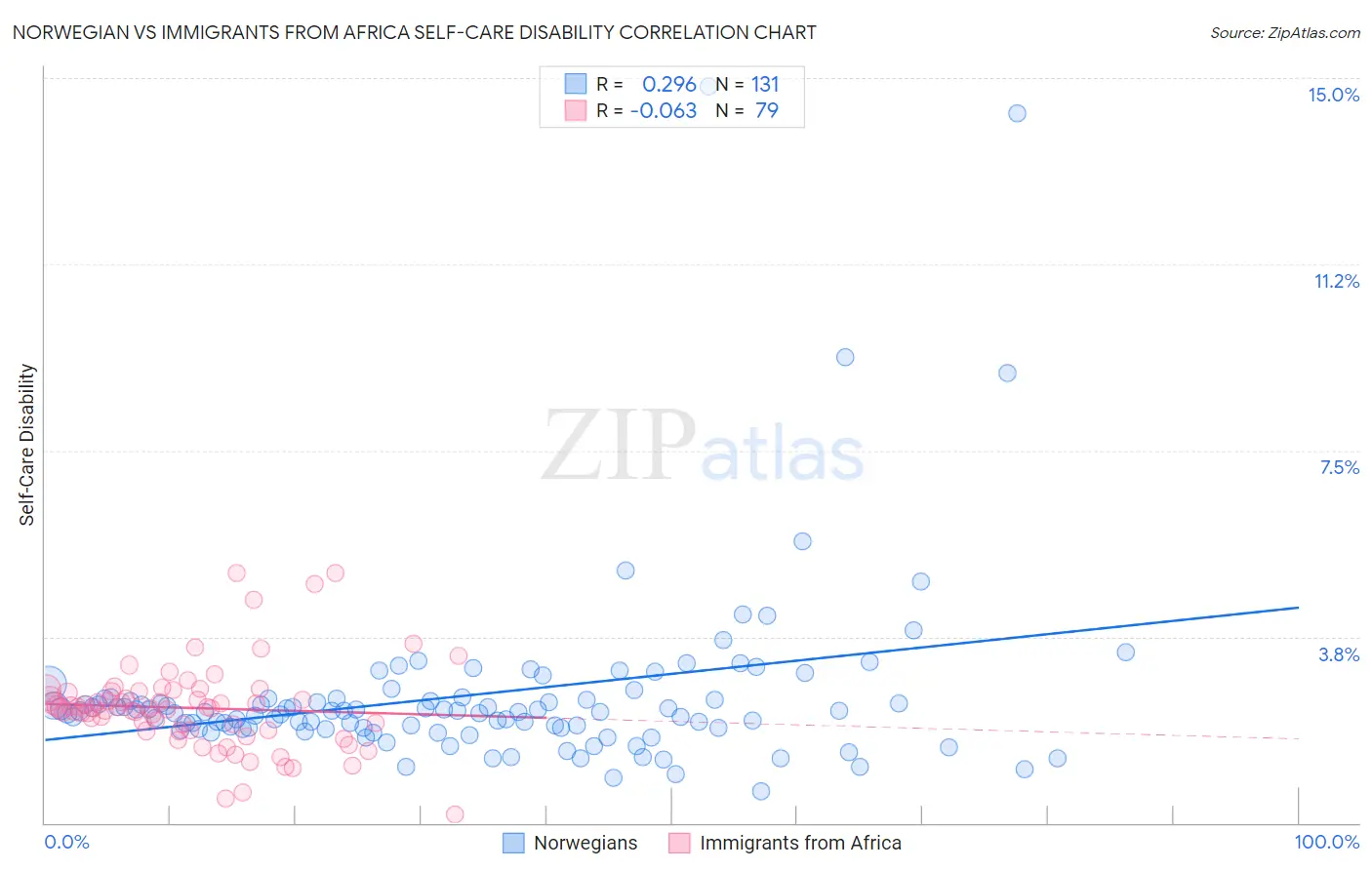Norwegian vs Immigrants from Africa Self-Care Disability
COMPARE
Norwegian
Immigrants from Africa
Self-Care Disability
Self-Care Disability Comparison
Norwegians
Immigrants from Africa
2.3%
SELF-CARE DISABILITY
99.8/ 100
METRIC RATING
45th/ 347
METRIC RANK
2.4%
SELF-CARE DISABILITY
93.7/ 100
METRIC RATING
110th/ 347
METRIC RANK
Norwegian vs Immigrants from Africa Self-Care Disability Correlation Chart
The statistical analysis conducted on geographies consisting of 531,593,682 people shows a weak positive correlation between the proportion of Norwegians and percentage of population with self-care disability in the United States with a correlation coefficient (R) of 0.296 and weighted average of 2.3%. Similarly, the statistical analysis conducted on geographies consisting of 468,498,120 people shows a slight negative correlation between the proportion of Immigrants from Africa and percentage of population with self-care disability in the United States with a correlation coefficient (R) of -0.063 and weighted average of 2.4%, a difference of 4.5%.

Self-Care Disability Correlation Summary
| Measurement | Norwegian | Immigrants from Africa |
| Minimum | 0.64% | 0.17% |
| Maximum | 14.8% | 5.0% |
| Range | 14.2% | 4.9% |
| Mean | 2.6% | 2.3% |
| Median | 2.2% | 2.3% |
| Interquartile 25% (IQ1) | 1.9% | 1.9% |
| Interquartile 75% (IQ3) | 2.5% | 2.6% |
| Interquartile Range (IQR) | 0.60% | 0.79% |
| Standard Deviation (Sample) | 1.9% | 0.87% |
| Standard Deviation (Population) | 1.9% | 0.87% |
Similar Demographics by Self-Care Disability
Demographics Similar to Norwegians by Self-Care Disability
In terms of self-care disability, the demographic groups most similar to Norwegians are Immigrants from South Africa (2.3%, a difference of 0.040%), Czech (2.3%, a difference of 0.080%), Immigrants from Pakistan (2.3%, a difference of 0.090%), Immigrants from Uganda (2.3%, a difference of 0.13%), and Immigrants from Sudan (2.3%, a difference of 0.23%).
| Demographics | Rating | Rank | Self-Care Disability |
| Immigrants | Eastern Africa | 99.9 /100 | #38 | Exceptional 2.3% |
| Immigrants | Bulgaria | 99.8 /100 | #39 | Exceptional 2.3% |
| Iranians | 99.8 /100 | #40 | Exceptional 2.3% |
| Immigrants | Sudan | 99.8 /100 | #41 | Exceptional 2.3% |
| Immigrants | Uganda | 99.8 /100 | #42 | Exceptional 2.3% |
| Immigrants | Pakistan | 99.8 /100 | #43 | Exceptional 2.3% |
| Immigrants | South Africa | 99.8 /100 | #44 | Exceptional 2.3% |
| Norwegians | 99.8 /100 | #45 | Exceptional 2.3% |
| Czechs | 99.8 /100 | #46 | Exceptional 2.3% |
| Jordanians | 99.7 /100 | #47 | Exceptional 2.3% |
| Immigrants | Malaysia | 99.7 /100 | #48 | Exceptional 2.3% |
| Latvians | 99.7 /100 | #49 | Exceptional 2.3% |
| Immigrants | Brazil | 99.7 /100 | #50 | Exceptional 2.3% |
| Kenyans | 99.7 /100 | #51 | Exceptional 2.3% |
| Immigrants | Serbia | 99.6 /100 | #52 | Exceptional 2.3% |
Demographics Similar to Immigrants from Africa by Self-Care Disability
In terms of self-care disability, the demographic groups most similar to Immigrants from Africa are Serbian (2.4%, a difference of 0.020%), Scandinavian (2.4%, a difference of 0.050%), Slovene (2.4%, a difference of 0.080%), Greek (2.4%, a difference of 0.090%), and South American (2.4%, a difference of 0.11%).
| Demographics | Rating | Rank | Self-Care Disability |
| Alsatians | 94.9 /100 | #103 | Exceptional 2.4% |
| Bhutanese | 94.5 /100 | #104 | Exceptional 2.4% |
| Carpatho Rusyns | 94.4 /100 | #105 | Exceptional 2.4% |
| Immigrants | Indonesia | 94.3 /100 | #106 | Exceptional 2.4% |
| British | 94.3 /100 | #107 | Exceptional 2.4% |
| Greeks | 94.1 /100 | #108 | Exceptional 2.4% |
| Slovenes | 94.1 /100 | #109 | Exceptional 2.4% |
| Immigrants | Africa | 93.7 /100 | #110 | Exceptional 2.4% |
| Serbians | 93.6 /100 | #111 | Exceptional 2.4% |
| Scandinavians | 93.5 /100 | #112 | Exceptional 2.4% |
| South Americans | 93.2 /100 | #113 | Exceptional 2.4% |
| Immigrants | North Macedonia | 93.1 /100 | #114 | Exceptional 2.4% |
| Immigrants | Hong Kong | 93.1 /100 | #115 | Exceptional 2.4% |
| Northern Europeans | 92.9 /100 | #116 | Exceptional 2.4% |
| Taiwanese | 92.5 /100 | #117 | Exceptional 2.4% |